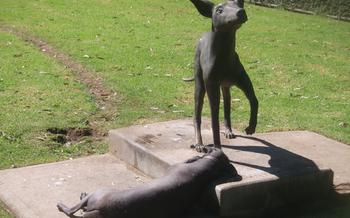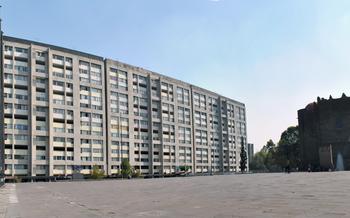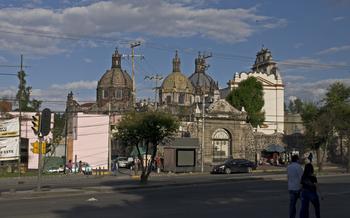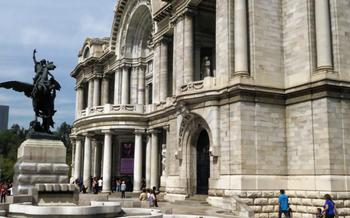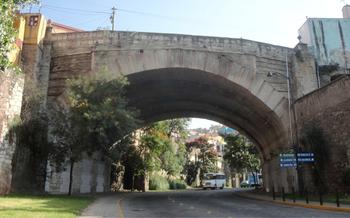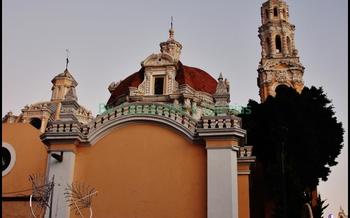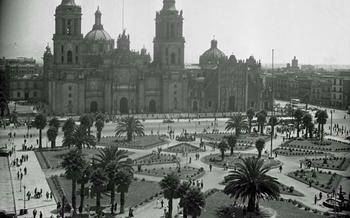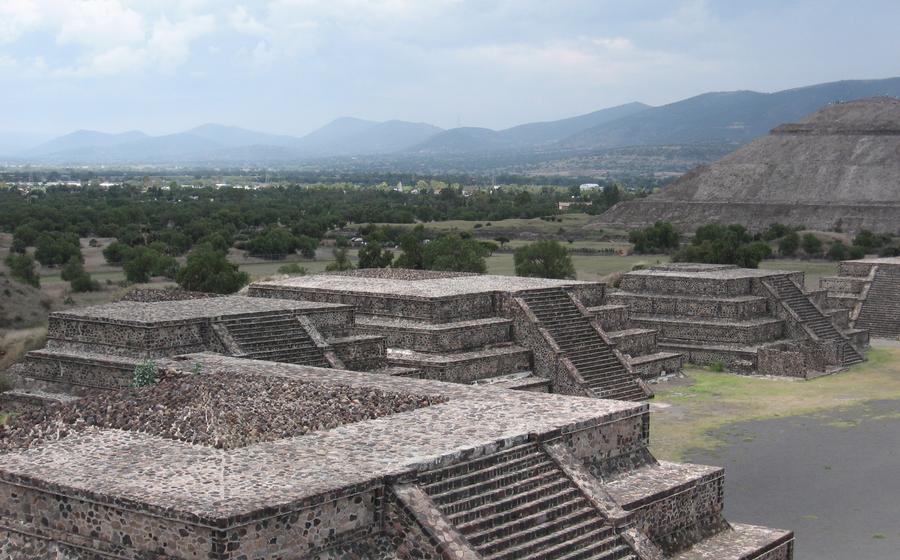
Museo Casa Estudio Diego Rivera y Frida Kahlo
- Museo Casa Estudio Diego Rivera y Frida Kahlo
- History of the museum
- Location and how to get there
- Hours of operation and admission fees
- Guided tours and other programs
- Diego Rivera and Frida Kahlo
- The Museum Building
- The Permanent Collection
- The Gardens
- Temporary Exhibitions
- Cultural Events
- Research Library
- Gift Shop
- Accessibility
- Photography and Videography
- Food and Beverages
- Nearby Attractions
- Insider Tip
Museo Casa Estudio Diego Rivera y Frida Kahlo
The Museo Casa Estudio Diego Rivera y Frida Kahlo is a museum in Mexico City dedicated to the lives and work of the Mexican artists Diego Rivera and Frida Kahlo. The museum is located in the house where the two artists lived and worked for over a decade. Rivera and Kahlo were two of the most important figures in the Mexican muralist movement, and their work played a significant role in the development of Mexican art. The museum houses a collection of their paintings, drawings, sculptures, and personal belongings. It also offers guided tours and other programs that allow visitors to learn more about the artists and their work.
History of the museum
The Museo Casa Estudio Diego Rivera y Frida Kahlo was founded in 1958, two years after Kahlo's death. The museum was created by Rivera, who donated the house and its contents to the Mexican government. The museum opened to the public in 1959, and it has since become one of the most popular tourist attractions in Mexico City.
Location and how to get there
The Museo Casa Estudio Diego Rivera y Frida Kahlo is located in the San Angel neighborhood of Mexico City. The museum is about 10 miles south of the city center, and it can be reached by public transportation or taxi. The closest metro station is Miguel Angel de Quevedo, and the museum is also served by several bus lines.
Hours of operation and admission fees
The Museo Casa Estudio Diego Rivera y Frida Kahlo is open to the public from Tuesday to Sunday, from 10am to 5pm. The admission fee for adults is 120 pesos, and the admission fee for children is 60 pesos. The museum offers guided tours in Spanish and English, and the cost of the tour is included in the admission fee.
Guided tours and other programs
The Museo Casa Estudio Diego Rivera y Frida Kahlo offers a variety of guided tours and other programs for visitors. The museum offers a guided tour in Spanish and English, and the cost of the tour is included in the admission fee. The museum also offers a variety of educational programs, including workshops, classes, and lectures.
Diego Rivera and Frida Kahlo
Diego Rivera (1886-1957) was a renowned Mexican painter, muralist, and political activist. Born in Guanajuato, Mexico, he studied art in Mexico City and Europe. Rivera's work is characterized by its bold colors, monumental scale, and depictions of Mexican history and culture. He is best known for his murals in the National Palace and the Palacio de Bellas Artes in Mexico City.
Frida Kahlo (1907-1954) was a Mexican painter known for her self-portraits, paintings of indigenous Mexican culture, and works inspired by the nature and artifacts of Mexico. She is celebrated for her resilience in the face of physical pain and emotional suffering. Her work has been praised for its honesty, emotional depth, and technical skill.
Rivera and Kahlo met in 1928 and married a year later. Their relationship was passionate and tumultuous, marked by infidelity, separation, and reconciliation. Despite their personal struggles, they collaborated on several artistic projects and shared a deep commitment to Mexican art and culture.
Rivera and Kahlo's artistic styles were distinct yet complementary. Rivera's work is characterized by its realism, monumentality, and political content, while Kahlo's work is more personal and introspective, often exploring themes of identity, pain, and sexuality. Their collaboration resulted in a unique and powerful body of work that has had a profound impact on Mexican art and culture.
The couple's stormy relationship and their impact on Mexican art and culture make them one of the most fascinating and influential artistic couples of the 20th century. Their legacy continues to inspire and captivate audiences worldwide.
The Museum Building
The Museo Casa Estudio Diego Rivera y Frida Kahlo is housed in a remarkable building that showcases the architectural vision of Juan O'Gorman, a renowned Mexican architect, and close friend of both Rivera and Kahlo. Constructed between 1931 and 1934, the building reflects the artists' commitment to combining traditional Mexican elements with modern design principles.
The building's striking design incorporates traditional Mexican elements, such as volcanic stone and colorful tiles, seamlessly blended with functionalist architecture. The exterior features geometric shapes and a minimalist aesthetic, while the interior boasts open spaces, high ceilings, and an abundance of natural light.
One of the most distinctive features of the museum is its unique studio spaces. Rivera and Kahlo each had their own dedicated studio, designed to accommodate their specific artistic needs. Rivera's studio is characterized by its large windows, providing ample natural light, while Kahlo's studio is more intimate, with a skylight that floods the space with soft, diffused light.
The museum has undergone extensive restoration and preservation efforts to maintain its original integrity and charm. These efforts have included structural reinforcements, roof repairs, and the restoration of original finishes and colors. The museum's dedication to preserving the building's authenticity ensures that visitors can experience the space as it was during Rivera and Kahlo's time.
Beyond its architectural significance, the Museo Casa Estudio Diego Rivera y Frida Kahlo holds profound symbolic and cultural meaning. It represents the convergence of art, architecture, and Mexican identity, embodying the spirit of artistic collaboration and the enduring legacy of two of Mexico's most celebrated artists.
The Permanent Collection
The Museo Casa Estudio Diego Rivera y Frida Kahlo houses a remarkable permanent collection that showcases the artistic genius of Diego Rivera and Frida Kahlo. The collection features a diverse range of their works, including paintings, drawings, sculptures, and personal belongings.
Among the highlights of the collection are Rivera's iconic mural, "The History of Mexico," which depicts the country's rich history from pre-Columbian times to the Mexican Revolution. Kahlo's works, such as "The Two Fridas" and "The Wounded Deer," offer a deeply personal and introspective glimpse into her life and struggles.
In addition to the works of Rivera and Kahlo, the museum also houses a collection of works by other renowned Mexican artists, such as José Clemente Orozco, David Alfaro Siqueiros, and Rufino Tamayo. These works provide a broader context for understanding the development of Mexican art during the 20th century.
Thematic exhibitions and displays are regularly organized to highlight specific aspects of Rivera and Kahlo's work or to explore broader themes in Mexican art. These exhibitions often feature works from other museums and private collections, offering visitors a unique opportunity to see rare and seldom-seen artworks.
The Gardens
The Museo Casa Estudio Diego Rivera y Frida Kahlo boasts stunning outdoor spaces that complement the artistic treasures within. Immerse yourself in the serene atmosphere of the gardens, designed by renowned landscape architect Carlos Obregón Santacilia. Wander through the lush greenery, vibrant flowers, and towering trees that create a tranquil oasis in the heart of Mexico City.
Discover sculptures and other artworks scattered throughout the gardens, adding a touch of artistic flair to the natural surroundings. These sculptures include works by Rivera, Kahlo, and other renowned Mexican artists, harmoniously blending art and nature.
The gardens are a testament to the couple's deep appreciation for the natural world. Native plants and landscaping techniques showcase the rich biodiversity of Mexico, creating a haven for local flora and fauna. Take a moment to relax in the peaceful atmosphere, soak in the beauty of the gardens, and find inspiration in the fusion of art and nature.
Temporary Exhibitions
The Museo Casa Estudio Diego Rivera y Frida Kahlo regularly hosts temporary exhibitions that showcase the work of contemporary artists, explore different themes related to Mexican art and culture, or delve deeper into the lives and careers of Rivera and Kahlo. These exhibitions offer a dynamic and ever-changing perspective on the museum's collection, providing visitors with new insights and experiences.
Current and upcoming exhibitions are announced on the museum's website, along with information about the featured artists, themes, and special events. The museum often collaborates with other institutions, such as universities, galleries, and cultural centers, to curate and present these exhibitions.
Temporary exhibitions at the Museo Casa Estudio Diego Rivera y Frida Kahlo are a great way to learn about new and emerging artists, discover different aspects of Mexican art and culture, and gain a deeper understanding of the work of Rivera and Kahlo. Visitors are encouraged to check the museum's website or social media pages for information about current and upcoming exhibitions.
Cultural Events
The Museo Casa Estudio Diego Rivera y Frida Kahlo is not only a place to admire art but also a vibrant cultural hub that hosts a diverse range of events throughout the year. These events aim to promote Mexican culture, celebrate the legacy of Rivera and Kahlo, and provide visitors with unique and immersive experiences.
One of the highlights of the museum's cultural program is the Frida Kahlo Festival, held annually to commemorate the artist's birthday. The festival features exhibitions, workshops, performances, and other activities that explore Kahlo's life, work, and influence. Visitors can enjoy traditional Mexican music and dance, participate in art-making activities, and learn more about Kahlo's impact on Mexican culture.
The museum also organizes regular concerts, performances, and readings by local and international artists. These events offer visitors the chance to experience a variety of artistic expressions, from classical music to contemporary dance, while immersing themselves in the beautiful surroundings of the museum.
Film screenings and discussions are another popular offering at the museum. Visitors can watch documentaries and feature films related to Mexican art and culture, followed by lively discussions with filmmakers, scholars, and artists. These events provide an opportunity for deeper engagement with the museum's collection and the broader context of Mexican history and culture.
The Museo Casa Estudio Diego Rivera y Frida Kahlo is also a popular venue for art markets and festivals. These events bring together local artisans, designers, and vendors, offering visitors a chance to purchase unique and handcrafted items inspired by Mexican culture and the work of Rivera and Kahlo. The markets are often accompanied by live music, food, and other entertainment, creating a festive and vibrant atmosphere.
By participating in the cultural events at the Museo Casa Estudio Diego Rivera y Frida Kahlo, visitors can gain a deeper understanding of Mexican art and culture, celebrate the legacy of two of Mexico's most renowned artists, and create lasting memories of their visit.
Research Library
The Museo Casa Estudio Diego Rivera y Frida Kahlo houses a comprehensive research library dedicated to the study of Mexican art and culture. The library's collection includes a vast array of books, journals, and other resources, ranging from historical texts to contemporary publications. Visitors can find in-depth analyses of Rivera and Kahlo's artworks, as well as broader studies of Mexican art history and theory.
The library also holds a significant collection of archival materials, including personal letters, sketches, and photographs that provide valuable insights into the lives and creative processes of Rivera and Kahlo. These primary sources are essential for researchers seeking to gain a deeper understanding of the artists and their contributions to Mexican art.
The library staff is knowledgeable and helpful, providing research assistance and guidance to visitors. They can help researchers identify relevant materials, navigate the collection, and access archival documents. The library also offers a variety of educational programs and workshops, including lectures, seminars, and classes, that provide opportunities for learning and engagement with scholars and experts in the field.
Gift Shop
The gift shop at the Museo Casa Estudio Diego Rivera y Frida Kahlo is a treasure trove of unique souvenirs and keepsakes inspired by the art and lives of these two iconic Mexican artists. Here, you can find a wide selection of books, prints, and postcards featuring reproductions of their most famous works. There are also a variety of other items, such as t-shirts, mugs, magnets, and jewelry, that make perfect gifts for friends and family back home.
Proceeds from the gift shop support the museum's educational programs, which help to promote the study and appreciation of Mexican art and culture. So, by purchasing a souvenir from the gift shop, you are not only taking home a piece of the museum experience but also contributing to its ongoing mission.
Accessibility
The Museo Casa Estudio Diego Rivera y Frida Kahlo is committed to providing a welcoming and accessible environment for all visitors. Wheelchair accessibility is ensured through ramps and elevators throughout the museum, allowing visitors with physical disabilities to navigate the spaces comfortably. Audio guides and descriptive materials are available for visitors with visual impairments, providing detailed information about the artworks and exhibitions. Upon request, the museum also offers sign language interpreters to facilitate communication for visitors who are deaf or hard of hearing. With these accessibility features in place, the museum strives to create an inclusive experience for visitors from all backgrounds and abilities.
Photography and Videography
The Museo Casa Estudio Diego Rivera y Frida Kahlo welcomes visitors to capture the beauty and significance of the museum through photography and videography. However, to ensure the preservation of the artworks and the privacy of other visitors, certain guidelines must be followed.
Photography for personal use is generally permitted, but the use of flash photography and tripods is strictly prohibited. This is to minimize the risk of damage to the delicate artworks and to avoid disturbing other visitors. Designated areas within the museum are marked where photography is allowed, and visitors are kindly requested to respect these designated spots.
Commercial photography and filming require prior permission from the museum administration. Professional photographers and videographers must obtain the necessary permits and follow specific guidelines to ensure the smooth operation of the museum.
By adhering to these guidelines, visitors can contribute to the preservation of the museum's treasures while capturing their own unique memories of the Museo Casa Estudio Diego Rivera y Frida Kahlo.
Food and Beverages
The Museo Casa Estudio Diego Rivera y Frida Kahlo offers a delightful on-site café known as "El Mural de los Amantes". The café is a charming space that seamlessly blends art and gastronomy, featuring a menu inspired by the vibrant colors and flavors of Mexican cuisine.
Visitors can savor a variety of dishes, including traditional Mexican breakfast options, light lunches, and refreshing beverages. The menu boasts an array of flavors, from hearty enchiladas and tacos to fresh salads and seasonal soups.
The café also offers a selection of delectable desserts, such as homemade flan, tres leches cake, and churros. These sweet treats are perfect for indulging in a moment of culinary bliss while admiring the surrounding artworks.
For those who prefer to enjoy a picnic in the serene outdoor spaces of the museum, there are designated picnic areas where visitors can spread out their blankets and savor their own packed lunches amidst the tranquil surroundings.
Please note that the museum has a BYOB policy, allowing visitors to bring their own alcoholic beverages to enjoy responsibly during their visit. However, it is important to adhere to the museum's guidelines and regulations regarding alcohol consumption on the premises.
Nearby Attractions
The Museo Casa Estudio Diego Rivera y Frida Kahlo is located in the vibrant and historic neighborhood of San Angel in Mexico City. In addition to the museum, there are several other notable attractions within walking distance or a short bus ride away. These include the Museo de Arte Carrillo Gil, which houses a collection of modern and contemporary Mexican art, as well as the Anahuacalli Museum, which showcases Diego Rivera's collection of pre-Columbian artifacts.
For those interested in history and architecture, the San Angel neighborhood itself is a treasure trove of colonial-era buildings and landmarks. The Plaza San Jacinto, with its colorful market and 17th-century church, is a must-visit. The Museo Casa del Risco, a former colonial mansion, now houses a museum dedicated to the history of San Angel.
For a break from the museums and history, visitors can head to the nearby Parque de los Venados, a beautiful park with gardens, playgrounds, and a small zoo. The park is a popular spot for picnics and outdoor activities.
For those who want to explore beyond San Angel, there are several day trips and excursions that can be easily arranged from the museum. A visit to the ancient city of Teotihuacan, with its iconic pyramids and temples, is a popular choice. Other options include a boat trip to the floating gardens of Xochimilco or a visit to the Frida Kahlo Museum in Coyoacán.
Insider Tip
To fully immerse yourself in the lives and art of Rivera and Kahlo, plan your visit for a weekday morning when the museum is less crowded. Arrive early to beat the heat and take your time exploring the galleries, gardens, and other hidden gems of the museum. One secret spot is the rooftop terrace, which offers stunning views of the surrounding San Angel neighborhood and the distant mountains. For a truly unforgettable experience, consider joining a guided tour led by a knowledgeable museum educator who can provide insights into the artists' lives and work, as well as the history and significance of the museum itself.
